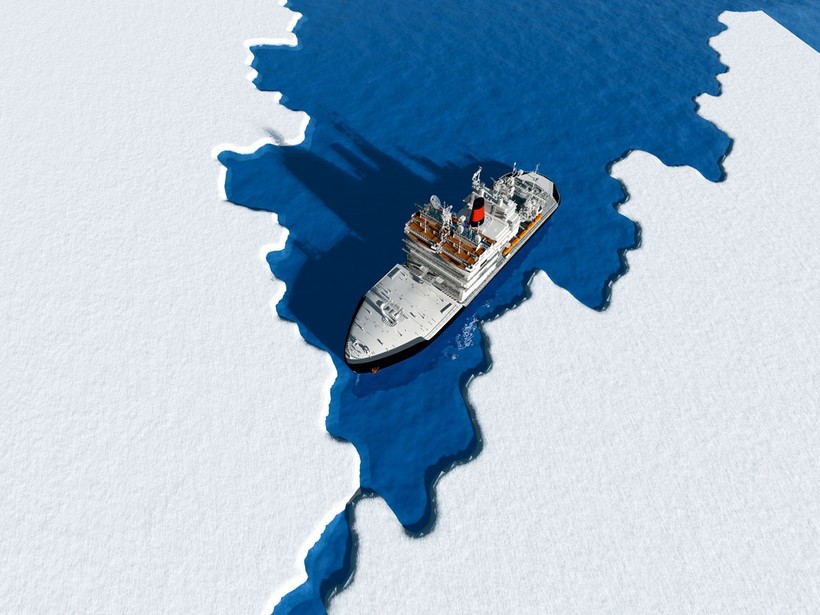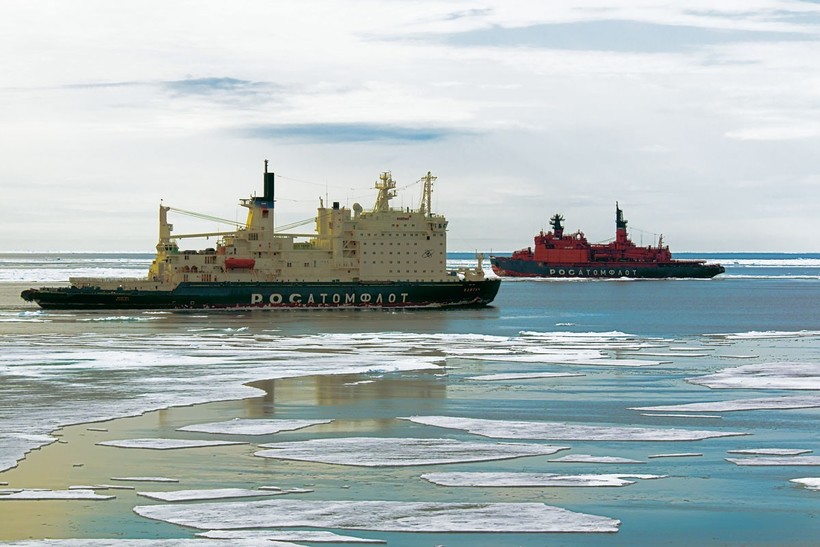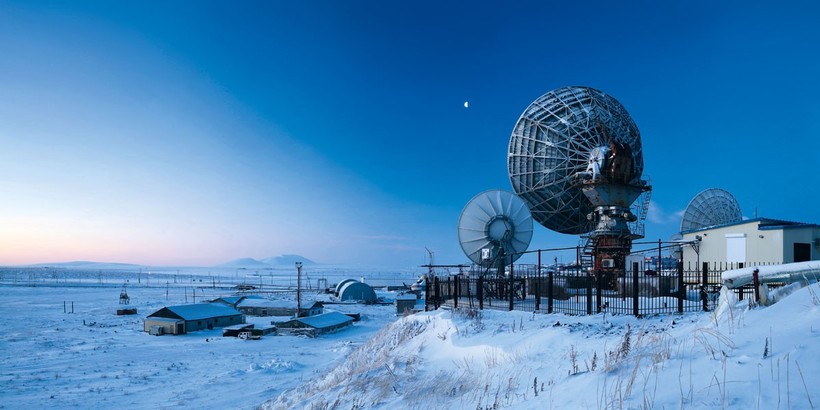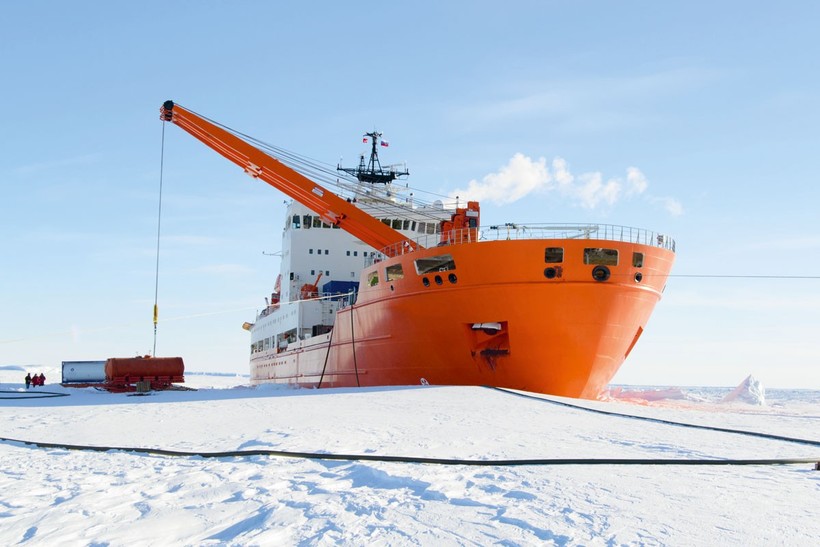Building up the Arctic
The Arctic is a strategic region and its development is among Russia’s priorities for the coming decades. The Northern Sea Route is a crucial pivot for the whole plan, providing a new trade transport alternative between Asia and Europe. To build up the Arctic effectively, a modern Arctic fleet and an Arctic shipping system will be needed, believes Nikita Dobroslasky.

Recently, once development of the
Arctic zone was officially declared a vital
strategic priority, in the words of President
Putin, Russia will this century build up the
Arctic, the government has started putting
more emphasis on the issue. In particular, a
corresponding strategy and a programme for
integrated development of the Arctic zone up
to 2035 have been developed and adopted. At
the same time, work has been stepped up on
developing the Northern Sea Route (NSR), as a
key factor for implementing this plan.
There is understandable interest in developing
this transport route. The NSR ensures national
security and strengthens Russia’s geopolitical
presence in the Arctic. At the same time, it is
also an important transport corridor, a key link
in the entire infrastructure.
The NSR is the
shortest sea route from Asia to Europe.
Since 2014, the traffic volume on the
NSR, with Atomflot and Rosatom as its only
operator, has been growing rapidly. During this
time, it has expanded around 5.5-fold, reaching
33 m tonnes by the end of 2020; and, according
to the plan, it should grow to 80 m tonnes by
2024. The volume of transit last year increased
by almost 1.2 m tonnes.
Such dynamics of cargo transportation along
the NSR have so far been primarily associated
with major projects extracting oil and gas, metals and ore, as well as with LNG production
in the Arctic. So far, in the current navigation
conditions in the seas of the Arctic Ocean,
the transport route is only cost-effective for
exporting hydrocarbons.
At the same time, the high potential of the NSR
is of great interest to all cargo transportation
market players. Leading transport companies
are already making trial voyages and pilotage
of ships, and are exploring opportunities for
infrastructure development in the region.
The
increasing shipping intensity adds to the NSR’s
appeal as a transit route.
With this in mind, it is already strategically
justified to develop the NSR not only
exclusively for exporting natural resources
from the Arctic zone or for Severny Zavoz
(Northern Supply Haul), but also for container
transportation. This is especially promising
since, owing to the intensifying global climate
change, the navigation conditions on the NSR
are likely to improve. It is expected that, already
after 2050, this route will become available
for year-round navigation by ships without ice
strengthening.
Improvement of the ice conditions in the
Arctic is already allowing an increasing number
of vessels to transit the NSR in summer and
autumn. Navigation in 2019 showed that the
increase in transit is due to use of low ice class
ships. This indicates that seasonal transit on the
NSR is developing.
A second major factor in shipping was the
reduction in the average duration of passage
through the NSR from 15 days in 2014 to 9.7
days in 2018. Based on the shipping statistics
in 2019, the average duration fell to 9.5 days.
This figure corresponds to an average speed of 13 mph, which is the recommended maximum
speed for ships in open pack ice. So, as a result
of navigation development on the NSR, the
passage time has come close to optimal and is to
stay between nine and ten days.
If we study the breakdown of transit, it still
consists mostly of raw materials, including oil,
iron ore and fertiliser. Even so, the volume of
finished goods transportation is also gradually
increasing. In particular, for three consecutive
years, the NSR has been used to supply towers
and equipment for wind farms in Europe.

AMBITION VS. REALITY
The plan is to achieve the nearest target
of cargo turnover for the NSR – which,
according to the state programme, is up to 80
m tonnes by 2024 – primarily by increasing the
transportation volume of products from new
mining enterprises. This is particularly expected to happen owing to launch of the 4th line of
the Yamal LNG project, which will add more
than 1 m tonnes (NGLs, LNG) to the cargo
base. Cargo traffic in the period up to 2030
will be determined by the projects launched
to produce LNG, by the supply of oil from the
Novoportovskoye field and delivery of cargo for
the second wave of Arctic megaprojects.
These
projects include LNG production at Arctic
LNG-2 and Ob LNG, as well as production
of oil by Vostok Oil. At the same time, there
is little certainty over coal projects. They are
not expected to be launched in the near future
without large-scale exploration works being
carried out first.
When conducting assessments as per the
protocols of the commissions for development
of major deposits in the Arctic and interviewing
subsoil users, the experts of the SKOLKOVO
Moscow School of Management determined an
alternative schedule for transportation through
the NSR: the volume amounted to about 50 m
tonnes a year by 2024, which is around 30 m
tonnes below the official targets of the state
programme.
Such a significant difference in official and
expert estimates is explained by the high risks
facing projects for industrial development of
deposits and processing of raw materials in the
Arctic region. On the one hand, such projects
in the Arctic rely on a high-quality resource
base while, on the other, they are implemented
in difficult climatic conditions and in remote
areas with a poorly developed infrastructure.
They are subject to sanctions, as well as to
a stricter climate regulation, and are also
sensitive to final product price fluctuations.
Given the ambitious stated production plans,
the volume of confirmed reserves is in some
cases too low to ensure sufficient cargo flow in
the long term.
To manage risk, companies must undertake
more complex logistics. In particular, this
includes using terminals for transshipment from
ice-class vessels to conventional vessels. At the
same time, Arctic projects receive substantial
tax and administrative support from the state.
The way these factors balance out will largely
determine whether the mining companies’
plans can be implemented in reality.
INFRASTRUCTURE OF THE NORTH
The NSR development concept is to implement
a comprehensive project with an international
status. The new route has to become competitive
in terms of global logistics. This is a conceptual
requirement for the Sevmorput National Project,
with a total cost of 735 billion rubles, including
budgetary funding of 274 billion rubles.
Modernisation and creation of a new
infrastructure in the Arctic region is a
prerequisite for its success. This includes ports,
a bunkering infrastructure, navigation services
and an emergency response infrastructure. In
particular, the plan provides for developing
the two main ports, Pevek and Sabetta, in the
period up to 2021 and developing the port
infrastructure to match the pace of industrial
development in the Russian Arctic.
The range of
activities includes personnel training, provision
of medical care and medical evacuation.
Measures to stimulate transit cargo traffic
include developing hub ports beyond the NSR:
the ports of Murmansk and PetropavlovskKamchatsky, and justifying establishment of a
container operator. According to the plan, the
latter will provide not only for transit, but also
multimodal transportation for domestic needs.
To provide energy for industrial projects, the
plan is to develop a single database of projects
with technological and energy parameters.
The
energy capacities that ensure development of
the NSR could be based on using LNG and
methanol, as well as renewable energy sources.
The infrastructure development plan
includes ensuring environmental safety during
navigation and port operations in NSR
waters, and comprehensively monitoring the
lithosphere, cryosphere, atmosphere, and
hydrosphere.
Consolidating the NSR infrastructure as
a single complex will ensure a high level of
shipping digitalisation, accounting for weather
conditions and the optimal route based on the weather and climate
conditions, as well as on analysis of satellite
images of the ice situation.
Artificial intelligence
elements can help in building optimal navigation
routes, which will reduce fuel consumption
and environmental impact, choosing the most
efficient fleet structure, and ensuring navigation
safety. As a result of digitalisation of oil exports
from the Prirazlomnaya platform and the Novy
Port field in the Barents Sea, the unit cost of
exporting one tonne of Arctic oil has fallen by
10%.

TANKERS AND ICEBREAKERS
Another prerequisite for achieving the NSR
development programme goals is to create a
modern fleet based on new Arctic-class vessels.
The fleet currently operating in the region
is not able to meet the set goals and needs to
be replaced or modernised as soon as possible.
According to data from the Russian Maritime Register of Shipping classification society, there
are 439 vessels of all classes registered in Russia’s
Arctic ports, most of them 20 or more years old.
Most vessels of the operating Arctic fleet are
relatively small, with a deadweight of up to one
thousand tonnes. Only two vessels, the Umba
and Natali tankers, have a deadweight of over
100 thousand tonnes. At the same time, almost
all the ships are fuelled by fuel oil and diesel. So,
to provide for export of manufactured products
using the NSR, a new Arctic fleet needs to be
built of vessels with an ice class of at least Arc4,
in order to allow for year-round navigation in
the Arctic.
The programme adopted for developing
the NSR implies building various types of
vessel. They include rescue and auxiliary fleets,
hydrographic vessels, container ships and cargo
ships, some of which use LNG as fuel.
Building a modern icebreaker fleet is itself
an extensive programme. Moreover, industrial
development of the Arctic requires a significant
increase not only in the number of icebreakers
but also in their size and capacity. For this
purpose, Baltic Shipyard enterprises (part
of the United Shipbuilding Corporation)
are currently building three Project 22220
icebreakers: the Arctic, Siberia and Ural. Yet,
fully-fledged navigation along the Northern
Sea Route will be possible only after the three
nuclear-powered Leader icebreakers ordered
from the Zvezda shipyard in the Far East
(managed by Rosneft) are commissioned.

ON THE TERMS OF TRANSIT
Despite a number of objective difficulties,
the government is assessing the potential for
transit shipping on the NSR, which might, in
the future, capture a share of the world’s cargo
sea traffic now travelling traditional routes. The
infamous incident of the week-long obstruction
of the Suez Canal due to the container ship
Ever Given running aground in March this year
once again revived interest in such alternatives.
Several trial voyages along the NSR have
already taken place. During these, a number
of major global transport companies evaluated
this route’s transportation prospects.
The
results make it clear that, in its current form,
the NSR cannot yet fully meet the requirements imposed. In particular, after a trial voyage
by the Venta Maersk container ship, Maersk,
a leading Danish company, claimed that
transportation on the NSR was futile since it
did not provide for year-round transit. In turn,
Sovfracht also expressed serious doubts about
the possibility of organising regular container
transportation. The main reason is said to be
the unpredictable weather conditions. Owing
to the navigation risks in the Arctic, some
major shipping companies have refused to use
the Arctic lines.
Even so, Rusatom Cargo, a subsidiary of
Rosatom, is evaluating development of an AsiaEurope container line within the Northern
Sea Transport Corridor (NSTC) project.
In
2020, the “Fundamentals of the State Policy
of the Russian Federation in the Arctic for the
Period up to 2035” officially documented a
change in the role of the NSR from a national
transport communication line to a competitive
international one.
Since year-round transit will not be possible
without building up an icebreaker fleet with
at least three icebreakers of the Leader class,
until 2030, transit schemes for the NSR can
be developed with the emphasis on seasonal
transit. According to its terms, cargo can be
transported between ports in Europe and Asia
and does not require mandatory transshipment
at Russian ports to ice class vessels.
In contrast to the volume of industrial
product export, choosing transport volumes
as a parameter for developing the NSR is an
oversimplified approach that could lead to
serious structural distortions. With seasonal
transit, there is a question of economic interest
for the Russian Federation, since ships transit
through the NSR without using ice-routing
services and the ports.
At the same time, Russia
remains responsible for ensuring the safety of
navigation and eliminating the consequences
of possible accidents. So, there is an issue of
determining the revenue centres that will ensure
the economic feasibility of developing transit
through the NSR.
Atomflot plans to establish a ship operator
for shipping on the NSR. A fleet of high ice-class vessels would make it possible to expand
the operator’s activities geographically from
the NSR to high latitudes. That is, it allows a
latitudinal operator to be set up to carry out
activities depending on the season: on the NSR
in winter and on the Northwest Passage in
summer.
It is important to remember that the current
requirements on the NSR as a transit route for
foreign customers relate to more aspects than just
the cost and duration of cargo transportation.
The scale of environmental and climate impact
is becoming an increasingly important factor.
Moreover, such requirements are put forward
not only by customers and cargo owners, but
even by the financial organisations that provide
for their operations.
In any case, if operation of the NSR is properly
organised, the stricter requirements imposed by
the world community on the environmental
aspects of transportation could become an
additional advantage for this route.
The
transit potential of the NSR is associated with
shipowners and their customers being able not
only to deliver cargo in a shorter time but also
to reduce specific emissions of pollutants and
greenhouse gases. An additional benefit might
consist in using cheaper marine fuels, including
those with a reduced carbon footprint, such as
LNG. Development of transit through the NSR
will provide conditions for modernising the
port infrastructure and for creating a modern
Russian fleet, as well as specialised national
Arctic logistics operators.
As a result of all this work, Russia will obtain
a new technological tool suitable not only for
successful competition in the modern world but
also for development of its own economy and
territories. This is how the theory of building
up the Arctic will translate into practice.

Nikita Dobroslavsky is expert at the
SKOLKOVO Moscow School of Management.










